1. Introduction
Hello. I'm Ilya. I am from St. Petersburg. I am 31 years old. For a long time I have had the main hobbies - batteries, electric transport and aviation.
In 2010, I learned about the most democratic way to find personal wings:
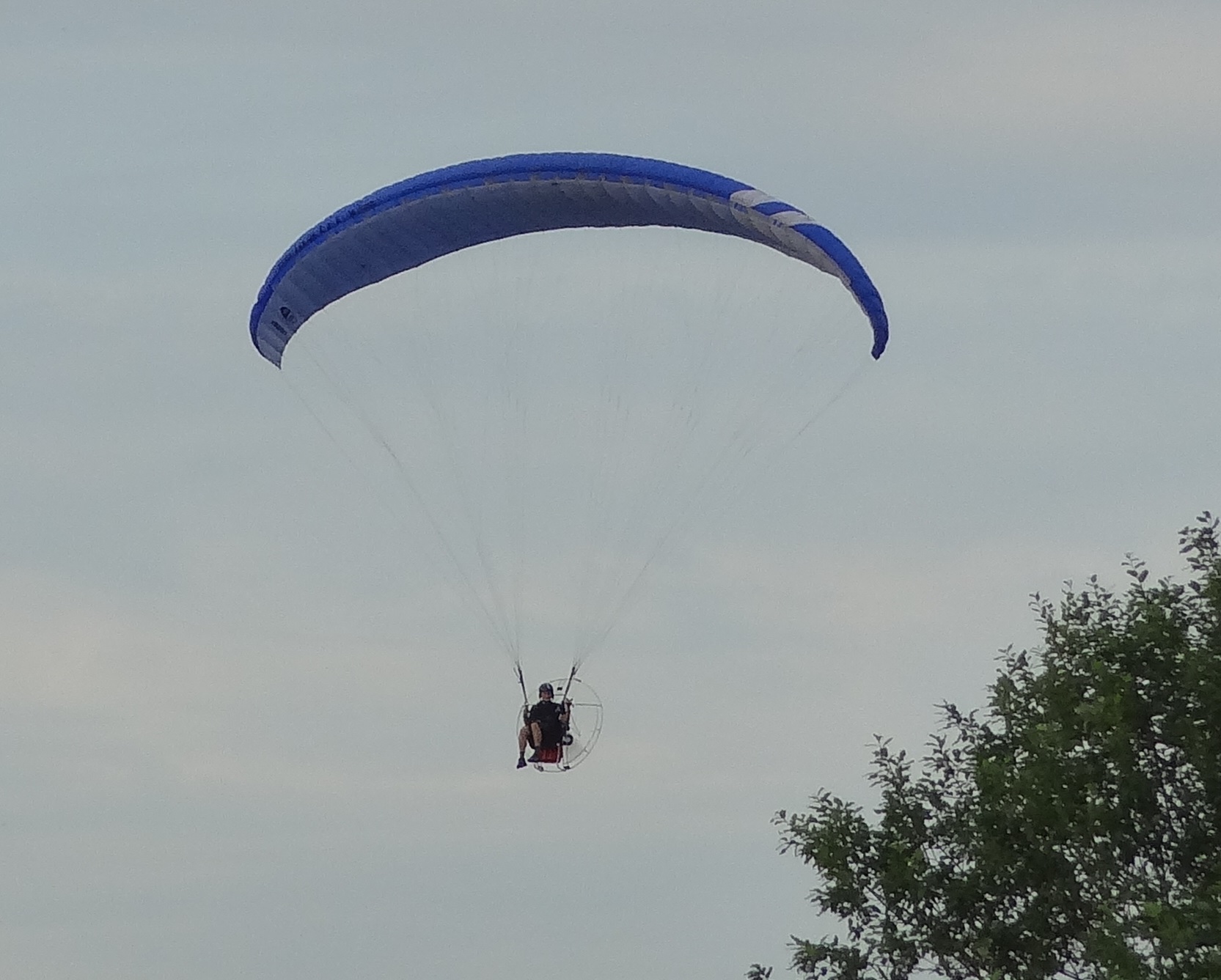
Paraglider with motor, paramotor, powered paraglider. The lightest and slowest representative of ultralight aviation.
This is truly an amazing thing! A real personal flying machine from films about the future, which made it possible to realize the dream of mankind to fly like a bird!
It consists of a separately purchased soft wing - a paraglider and a power plant - a satchel with an engine and a screw, worn on the back. You can fly at altitudes from zero to 5000 meters with speeds from 35 to 75 km / h. There are versions with wheels and a second passenger seat - paratrikes.
This whole thing takes off right from the ground. No "jumping from the hill" is needed. All that is needed is an even, rolled glade and in a radius of 200-300 meters so that there are no trees, wires, poles, houses and other things. On the Internet, for the query “paramotor takeoff” there are many videos on this subject. Yes, you should strictly observe the restrictions on weather conditions and the Air Code of the Russian Federation is a separate significant amount of knowledge required for study. Also, the topic for another conversation is to master the flights on this thing - as a rule, it takes about 3 months with an experienced instructor.
In the period from 2011 to 2016, I was actively flying hundreds of hours and thousands of kilometers of routes on a factory installation with the Moster-185 internal combustion engine:
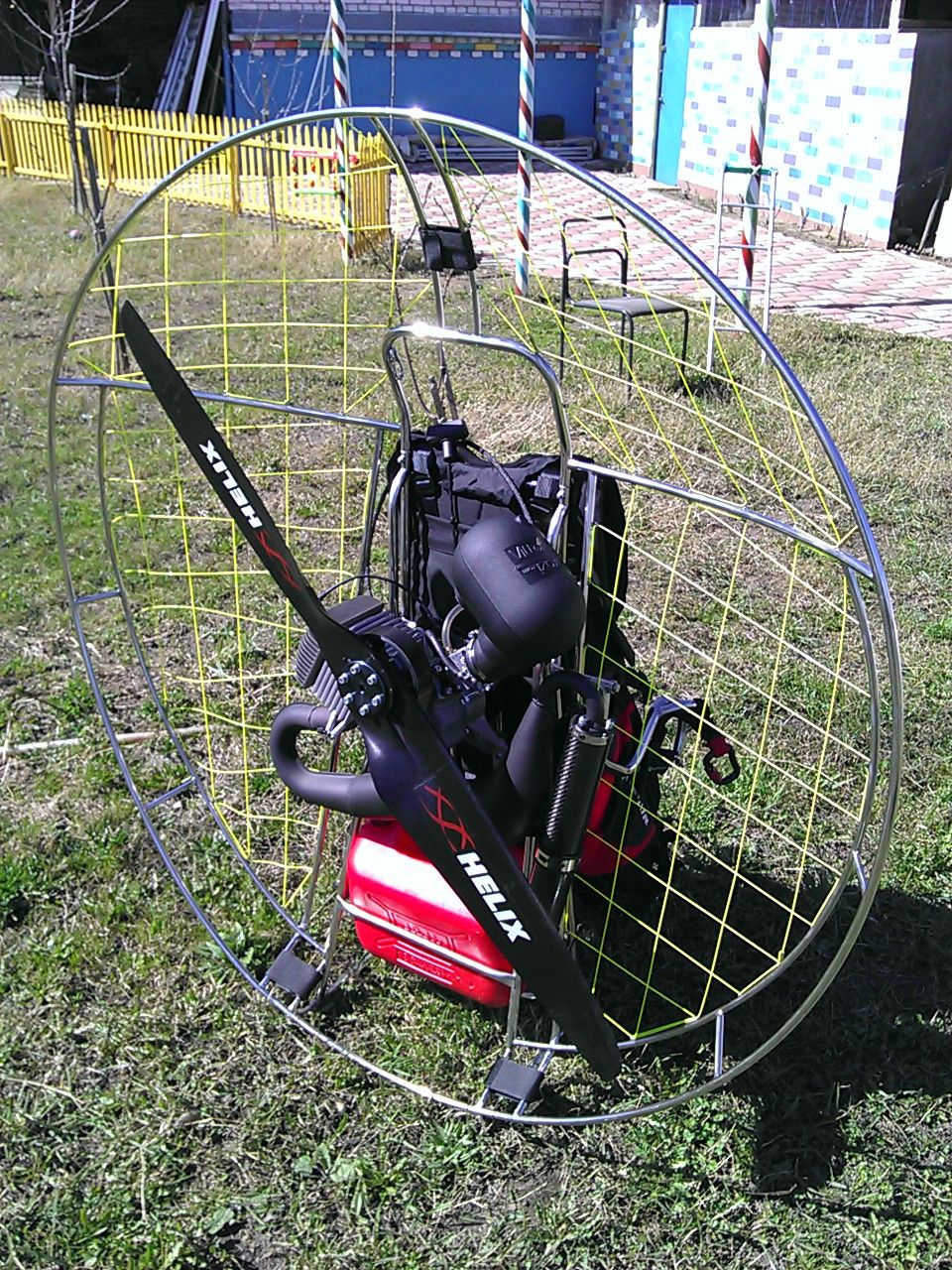
Brief information on it.
The engine is two-stroke gasoline, single-cylinder, 185 cc. Max power 25 hp (18 kW), max rotation on the crankshaft - 8300 rpm, max rotation on a screw with a diameter of 125 cm - 2950 rpm, max static traction - 70 kg, fuel consumption in a straight flight without a set - about 3-4 liters / hour. Paramotor weight - 25 kg.
It flew on the paramotor Moster-185 amazingly. Powerful, reliable, tore off the ground in a few steps with a small headwind. It was possible to fly on one tank for three hours without stopping, which at a wing speed of 40 km / h gave more than a hundred kilometers of “run”.
However, there were also disadvantages:
- requirements for refueling with high-quality 95-m gasoline and expensive synthetic oil;
- noise, vibrations from two-stroke;
- the smell, the constant claims of the apartment’s neighbors that “it stinks, you are poisoning us all” (yes, I kept the paramotor in the apartment, and even the rented one, with the neighbors in other rooms);
- the need to carry out frequent maintenance is to replace springs that wear out from vibrations, silent blocks, gaskets, inspect nuts, welds and a bunch of everything before each flight.
In parallel, there was already an established practice of riding an electric bike of several tens of thousands of kilometers and many assembled Li-ion batteries for wheeled electric vehicles.
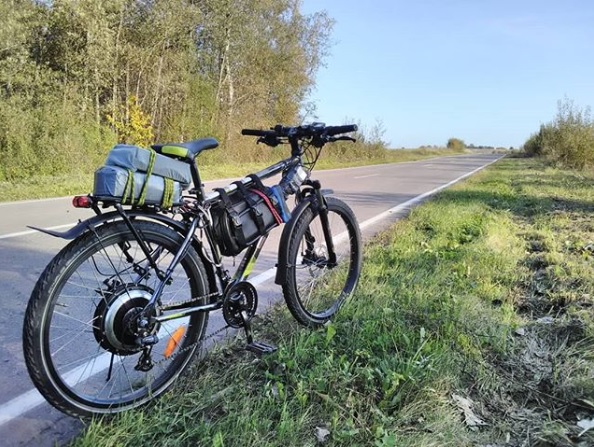
At some point, the idea of combining the world of electricity and the world of aviation as a whole has become very obsessive.
He was very interested in the principle of "take off on batteries", as well as try in the device, which was supposed to:
- have a reduced noise level;
- ensure the absence of shaking and vibration;
- Do not need fuel and consumables;
- Do not require ongoing inspections and maintenance.
The first thing I started with is with aviation theory, to understand whether it was worth getting involved in this topic at all then.
I would like to repeat the theoretical calculations that I did 6 years ago again, but already in the presence of interested readers.
2. Calculation of required power for horizontal flight. Takeoff mode
The first thing to understand is that for all its apparent similarity to a parachute or even an inflatable balloon (I heard such associations), the paraglider is a wing with the most typical aerodynamic wing profile. How a plane flies and how a paraglider flies has a lot in common. Both the plane and the paraglider - in order to create lift and keep themselves in the air - it is necessary to constantly move forward through the air. And to move through the medium - you need a mover that will overcome its (this environment) resistance.
Any aircraft based on wings - has such an indicator as "aerodynamic quality." This is an indicator of the aerodynamic perfection of the aircraft, a kind of analogue of its "efficiency" (may severe technicians forgive me such a frivolous comparison). The larger the AK - the lower the percentage of thrust from the weight necessary to keep the device in the air so that it does not lose altitude. If the engine is turned off and does not give traction - then the aircraft will slowly decline - plan. And here AK shows the ratio of horizontal and vertical speeds.
Flying on a gasoline engine, I measured in several flights my speed and the speed of descent with the engine turned off.
The values were as follows: a speed of 10.3 m / s (measured by GPS in calm), a descent speed of 1.5 m / s (measured by a Brauninger IQ One paraglider variometer).
Experimentally obtained AK = 6.8
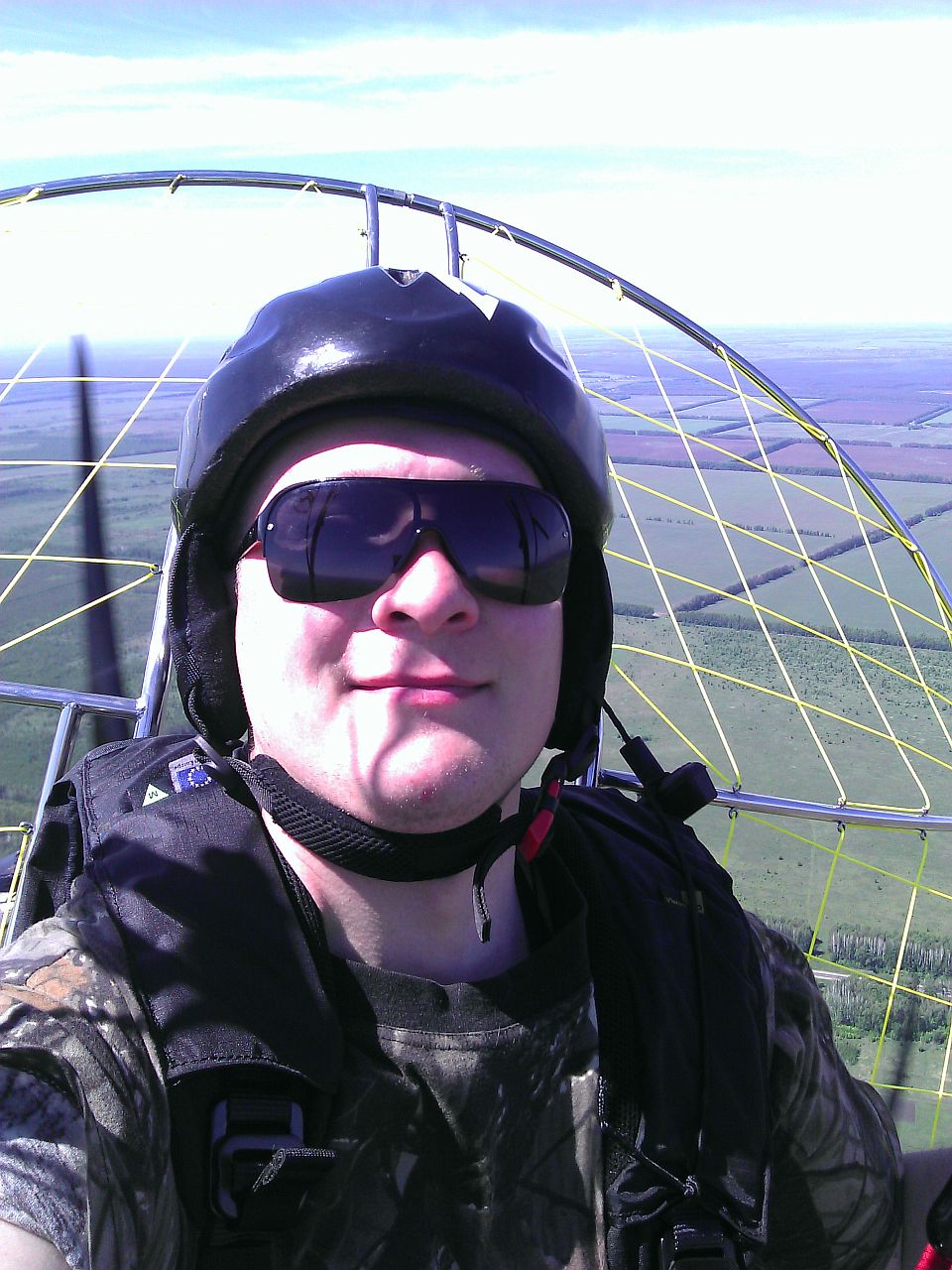
It was not difficult to calculate the take-off weight by adding the weight of my body, wing and installation - about 127 kg, and if a strict definition of weight - then about 1250 Newton.
Divide the weight by AK - 1250 / 6.8 = 183 N of required traction.
Now we need to somehow go from the magnitude of the required thrust to the mechanical power on the propeller shaft. And here the lines of formulas should go.
But fortunately, there is such a wonderful Propeller Selector program, tested by aircraft modelers (and paramotorists). We substitute our screw data, the number of blades, airspeed and voila:
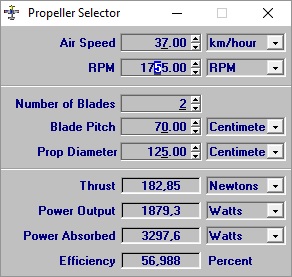
The mechanical power that must be brought to the propeller was about 3300 watts.
The circuit of the electric paramotor is simple: battery, BLDC controller, brushless motor.
It is necessary to take the efficiency of each link:
- battery, wires 97% (internal resistance);
- 99% controller
- motor 87%.
Final efficiency: 83.5% (it should be said here that the efficiency depends on the required power, so in the right way, I have to make a few iterations. But since I already know the result and I don’t want to make the article very long, I consciously omit some moments).
3300 W / 0.835 = 3950W.
Almost 4 kW of continuous power consumption. Let's stop for a moment and think. What is 4 kW? That is pretty much!
- this is an apartment in which they turned on a kettle, vacuum cleaner, computer, lights and a washing machine;
- it is an opportunity to ride an electric bike at a speed of 70 km / h;
- it's as much as 72A at a voltage of 55V.
But that's not all. We need to somehow break away from the planet and begin to gain initial height. 4 kW we can only compensate for the paraglider’s own decline of 1.5 m / s, and if we want to gain another 1.5 m / s in height, then we need another 4 kW. And even more. If you play with the Propeller Selector program, you can see that the more power we pump into the propeller, the worse its efficiency is:

(Amateurs of aircraft modeling often have versions why the propeller’s efficiency decreases with increasing speed. And somehow they couldn’t hear the correct version. Everyone sins on the imperfection of the propeller’s geometry, on the turbulence, but the matter is in the fundamental laws of physics. When the blade speed increases according to the linear law - its thrust grows quadratically, and the power consumption to overcome air resistance increases cubically. In simple words, the faster we spin the propeller, the more energy is consumed to disperse the air and less energy is left to us, since our the airspeed cannot increase due to the specifics of the paraglider’s operation. Here you need to add information for those who did not fly on the paramotor - the paraglider flies at almost the same speed regardless of whether the engine is running or not. The speed does not depend on gas. Why is this also a separate topic for conversation).
The program showed us 8.36 / 0.835 = 10 kW of consumed electric power at take-off.
Translated to horsepower - it's about 14 hp. This value is perfectly consistent with the maximum power of the lightest engines on the engine. You can’t do less - you won’t take off.
At a voltage of 55V, it begins to talk about current collection from a battery of more than 200A.
3. How are our batteries or a compact 10 kW power source?
From the very beginning, I did not want to mess with lithium-polymer model aircraft batteries. It was known that they would pull such a load. But I did not like the stories about their swelling, explosions, there were some strange rumors that they were enough for only 50 discharge-charge cycles.
By that time, vape culture and the practice of mass use of 18650 elements for very loaded scenarios began to develop.
Unlike notebook cells, the new generation did not use cobalt chemistry, but NMC - nickel-manganese-cobalt, which provided large peak discharge currents, a large specific capacity, a lower price year after year, and a small reduction in the number of discharge-charge cycles as a payoff compared to LiCoO2 (from 1000 to 500).
From the very beginning, I liked the 18650 format - a steel body, an emergency valve for relieving pressure, the convenience of soldering / welding, the ability to set the desired shape of the battery.

Confused only the declared inscriptions in datasheets on high-current 18650: "15A", "20A".
Intuition suggested that in an uncooled assembly, where many cells warm each other side by side, the maximum current collection will be much less.
A clear technique was required to assess the ability to remove large continuous currents from a compact battery.
The idea was simple: the battery has internal resistance. She also has a specific heat. Knowing the removed current - you can calculate the power that is lost inside the battery for self-heating. Knowing the time - you can estimate the temperature increase in degrees of the entire battery pack through heat energy and heat capacity.
After conducting a series of experiments with battery-powered battery assemblies, the experimental heat capacity of the material from which Li-ion cells were made was 0.25 Wh / kg-degree (by the way, this almost coincided with the data on foreign electric transport portals - “795 J / kg * K Specific Heat Capacity for Li-Ion (0.22 Wh / kgxC) ”).
Clause 3.1. Estimated Flight Time
On paramotors with internal combustion engines for two or three hours, hanging in the air is not the limit. Sometimes flights had to be stopped due to physical fatigue, and not exhaustion of fuel reserves.
With batteries, this trick will not work.
Nevertheless, I wanted to get the maximum time spent in the air from one charge.
The maximum weight of the unit, with which it is still comfortable to run, is 30 kg.
Of 30 kg - 7 kg goes to the BLDC motor + screw, 1 kg of wire + controller, 10 kg - suspension system + metal frame.
There remains 12 kg of weight under the battery.
LG-HG2 cells were selected as combining the minimum internal resistance and maximum capacity for the 18650 format:

Their energy density is about 0.22 kWh / kg.
The total energy reserve is 12 kg / (0.22 kWh / kg) = 2.6 kWh (240 cells).
Spoiler:
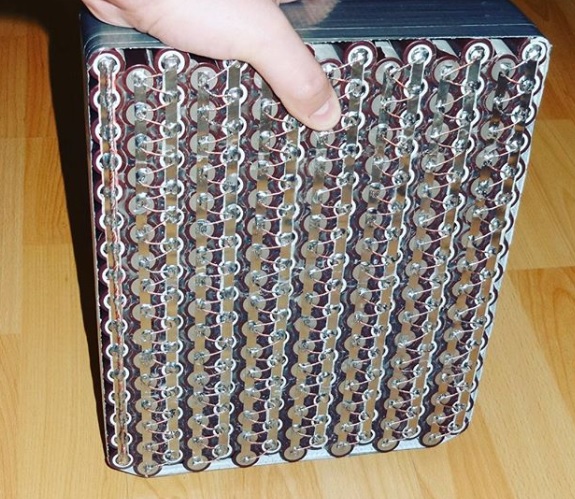
We calculate the horizontal flight time without taking into account the peak current at take-off:
2.6 / 4 = 0.65 hours or 39 minutes.
Clause 3.2. Battery heating rating
It should be noted right away that the battery did not initially provide for any forced cooling.
- This would increase the complexity of the assembly and delay the first flights for an indefinite period.
- Our team of specialists did not have a person who could correctly calculate the cooling system. Intuition suggested that a simple cooler would do little to help. (A battery weighing 12 kg would at an estimated level only require pumping through itself many tens of kg of air - and this is tens of cubic meters in a few tens of minutes).
- The dimensions and weight of the battery would increase, which is extremely undesirable for a knapsack installation, which has very limited weight parameters.
The calculation was based solely on the conditions that by the end of the discharge, the battery would barely get to the thermal limits of 60 degrees, specified by the cell manufacturer as limit.
In addition, a theoretical analysis of heating showed that, at first, forced cooling can be dispensed with.
Given:
- 15S16P build configuration
- load current - 72A
- DC battery internal resistance - 24 mOhm (measured experimentally)
- flight time - 0.65 hours
- battery weight - 12 kg
Heat dissipation inside the battery: (75 A) ^ 2 x 0.024 Ohm x 0.65 h = 88 Wh (Joule-Lenz law)
Temperature increase: (88 Wh / 12 kg) /0.23 Wh / kg-degree = 32 degrees.
If we assume that the electric paramotor is taken out of the living room with a temperature of 25 degrees, then after the flights the battery reaches a temperature of 25 + 32 = 57 degrees, which fits into the temperature limits.
Conclusions:
- Modern batteries are suitable for solving the problem of creating a personal aircraft with a flight duration of about half an hour;
- The small internal resistance of high-current NMC cells allows, to a first approximation, dispense with forced cooling systems;
- The increase in the duration of stay in the air of an aircraft using a paraglider as a supporting wing, in conditions of a limited supply of energy - should include an integrated approach:
- the use of a paraglider with maximum aerodynamic quality;
- increasing the diameter of the screw in order to increase its efficiency;
- reduction in take-off weight (yes, including the use of diets for weight loss);
- reducing the weight of the frame, suspension in order to release it for additional battery cells;
- the use of 3500 mAh cells, with a slightly larger internal resistance, instead of 3000 mAh with repeated thermal calculation.
Continued in the next article: “How to take off on batteries or the practice of operating SkyMax electric paramotor. Part 2"